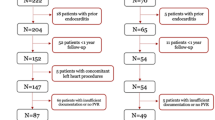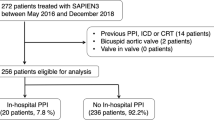Abstract
Recent data showed a right ventricular dyssynchrony in patients with tetralogy of Fallot (TOF). Percutaneous pulmonary valve implantation (PPVI) has become an important procedure to treat a pulmonary stenosis and/or regurgitation of the right ventricular outflow tract in these patients. Despite providing good results, there is still a considerable number of nonresponders to PPVI. The authors speculated that electrical dysfunction of the right ventricle plays an underestimated role in the outcome of patients after PPVI. This study aimed to investigate the influence of right ventricular electrical dysfunction, i.e., right bundle branch block (RBBB) on the RV remodeling after PPVI. The study included consecutive patients after correction of TOF with or without RBBB, who had received a PPVI previously at the Heart Center of the University of Leipzig, Germany during the period from 2012 to 2015. 24 patients were included. Patients without RBBB, i.e., with narrow QRS complexes pre-intervention, had significantly better RV function and had smaller right ventricular volumes. Patients with pre-interventionally QRS width below 150 ms showed a post-interventional remodeling of the right ventricle with the decreasing RV volumes (p = 0.001). The parameters of LV function and volume as well as RV ejection fraction remained unaffected by RBBB. The presented data indicate that the QRS width seems to be a valuable parameter in the prediction of right ventricular remodeling after PPVI, as it represents both electrical and mechanical functions of the right ventricle and may serve as an additional parameter for optimal timing of a PPVI.
Similar content being viewed by others
References
Hui W, Slorach C, Dragulescu A, Mertens L, Bijnens B, Friedberg MK (2014) Mechanisms of right ventricular electromechanical dyssynchrony and mechanical inefficiency in children after repair of tetralogy of Fallot. Circ Cardiovasc Imaging 7:610–618
Thambo JB, De Guillebon M, Dos Santos P et al (2011) Electrical dyssynchrony and resynchronization in tetralogy of Fallot. HRTHM 8:909–914
Thambo JB, Dos Santos P, De Guillebon M et al (2010) Biventricular stimulation improves right and left ventricular function after tetralogy of Fallot repair: acute animal and clinical studies. HRTHM 7:344–350
Kubuš P, Materna O, Tax P, Tomek V, Janousek J (2014) Successful permanent resynchronization for failing right ventricle after repair of tetralogy of Fallot. Circulation 130:186–190
Kogon BE, Rosenblum JM, Mori M (2015) Current readings: issues surrounding pulmonary valve replacement in repaired tetralogy of Fallot. Semin Thorac Cardiovasc Surg 27:57–64
Cools B, Brown SC, Heying R et al (2015) Percutaneous pulmonary valve implantation for free pulmonary regurgitation following conduit-free surgery of the right ventricular outflow tract. Int J Cardiol 186:129–135
Borik S, Crean A, Horlick E et al (2015) Percutaneous pulmonary valve implantation: 5 years of follow-up: does age influence outcomes? Circ Cardiovasc Interv 8:e001745
Lurz P, Coats L, Khambadkone S, Nordmeyer J, Boudjemline Y, Schievano S et al (2008) Percutaneous pulmonary valve implantation: impact of evolving technology and learning curve on clinical outcome. Circulation 118:1964–1972
Tweddell JS, Simpson P, Li SH et al (2012) Timing and technique of pulmonary valve replacement in the patient with tetralogy of Fallot. Semin Thorac Cardiovasc Surg Pediatr Card Surg Annu 15:27–33
Sarris GE et al (2012) Results of reparative surgery for tetralogy of Fallot: data from the European Association for Cardio-Thoracic Surgery Congenital Database. Eur J Cardiothorac Surg 42:766–774
Motonaga KS, Dubin AM (2014) Cardiac resynchronization therapy for pediatric patients with heart failure and congenital heart disease: a reappraisal of results. Circulation 129:1879–1891
Janousek J, Vojtovic P, Hucín B, Tláskal T, Gebauer RA, Gebauer R, Matejka T, Marek J, Reich O (2001) Resynchronization pacing is a useful adjunct to the management of acute heart failure after surgery for congenital heart defects. Am J Cardiol 88:145–152
Dubin AM, Feinstein JA, Reddy VM, Hanley FL, Van Hare GF, Rosenthal DN (2003) Electrical resynchronization: a novel therapy for the failing right ventricle. Circulation 107:2287–2289
van Gelder BM, Bracke FA, Meijer A, Lakerveld LJ, Pijls NH (2004) Effect of optimizing the VV interval on left ventricular contractility in cardiac resynchronization therapy. Am J Cardiol 93:1500–1503
Alexander ME, Berul CI, Fortescue EB, Blume E, Brown D, Triedman JK, Walsh EP, Cecchin F (2004) Who is eligible for cardiac resynchronization therapy in pediatric cardiology. Heart Rhythm 1:122–123
Author information
Authors and Affiliations
Corresponding author
Ethics declarations
Conflict of interest
The authors declare that they have no conflict of interest.
Ethical Approval
All procedures performed in human participants were in accordance with the ethical standards of the institutional research committee and with the 1964 Helsinki declaration and its later amendments.
Informed Consent
Informed consent was obtained from all individual participants included in the study.
Rights and permissions
About this article
Cite this article
Paech, C., Dähnert, I., Riede, F.T. et al. QRS Width as a Predictor of Right Ventricular Remodeling After Percutaneous Pulmonary Valve Implantation. Pediatr Cardiol 38, 1277–1281 (2017). https://doi.org/10.1007/s00246-017-1658-x
Received:
Accepted:
Published:
Issue Date:
DOI: https://doi.org/10.1007/s00246-017-1658-x




